Bowers & Wilkins CDM 1 SE User manual
- Category
- Soundbar speakers
- Type
- User manual

O W N E R ’ S M A N U A L
C D M
™
1SE & CDM
™
2SE

C D M ™ 1 S E C D M ™ 2 S E
C D M
™
1SE & CDM
™
2 S E
O w n e r ’s manual
E n g l i s h. . . . . . . . . . . . . . . . . . . . . . . . . . . . . . . . . . . . . . . . . .1
F r a n ç a i s. . . . . . . . . . . . . . . . . . . . . . . . . . . . . . . . . . . . . . . .2
D e u t s c h. . . . . . . . . . . . . . . . . . . . . . . . . . . . . . . . . . . . . . . . .3
E s p a ñ o l . . . . . . . . . . . . . . . . . . . . . . . . . . . . . . . . . . . . . . . . .4
P o rt u g u ê s . . . . . . . . . . . . . . . . . . . . . . . . . . . . . . . . . . . . . . 5
I t a l i a n o . . . . . . . . . . . . . . . . . . . . . . . . . . . . . . . . . . . . . . . . .6
N e d e r l a n d s. . . . . . . . . . . . . . . . . . . . . . . . . . . . . . . . . .7
Ε λ λ η ν ι κ À . . . . . . . . . . . . . . . . . . . . . . . . . . . . . . . . . . . .8
. . . . . . . . . . . . . . . . . . . . . . . . . . . . . . . . . . . . . . . .1 0
. . . . . . . . . . . . . . . . . . . . . . . . . . . . . . . . . . . . . . . .1 1
" e s k y . . . . . . . . . . . . . . . . . . . . . . . . . . . . . . . . . . . . . . . . .1 2
P o l s k i. . . . . . . . . . . . . . . . . . . . . . . . . . . . . . . . . . . . . . . . . .1 3
Р óñ ñ ê è é. . . . . . . . . . . . . . . . . . . . . . . . . . . . . . . . . . . .1 4
S l o v e n s k o. . . . . . . . . . . . . . . . . . . . . . . . . . . . . . . . . . .1 5
D a n s k. . . . . . . . . . . . . . . . . . . . . . . . . . . . . . . . . . . . . . . . .1 6
S u o m i. . . . . . . . . . . . . . . . . . . . . . . . . . . . . . . . . . . . . . . . .1 7
S v e n s k a . . . . . . . . . . . . . . . . . . . . . . . . . . . . . . . . . . . . . .1 8

G B
1
I N T R O D U C T I O N
Thank you for choosing B&W.
Please read this manual fully before
unpacking and installing the product.
It will help you to optimise its perf o rm a n c e .
B&W maintains a network of dedicated
distributors in over 60 countries who will be
able to help you should you have any pro b l e m s
your dealer cannot re s o l v e .
U N PACKING
( f i g u re 1)
• Fold the carton flaps right back and
i n v e rt the carton and contents.
• Lift the carton clear of the contents.
• Remove the inner packing from
the pro d u c t .
We suggest you retain the packing
for future use.
Check in the carton for:
• 2 foam plugs.
P O S I T I O N I N G
( f i g u re 2a)
Mount the speakers on firm dedicated stands
that place the tweeters approximately at ear
level. Bookshelf mounting is possible but allows
less opportunity for optimising the sound. The
stand or shelf used can affect the sound quality
of the speaker. Ask your dealer for advice on
the best type for your needs.
As an initial guide:
• Position the speakers and the centre
of the listening area approximately at
the corners of an equilateral triangle.
• Keep the speakers at least 1.5m apart
to maintain left-right separation.
• Keep the speaker baffles at least
0.5m clear of walls.
Stray magnetic fields
The speaker drive units create stray magnetic
fields that extend beyond the boundaries of the
cabinet. We recommend you keep magnetically
sensitive articles (television and computer
s c reens, computer discs, audio and video tapes,
swipe cards and the like) at least 0.5m fro m
the speaker.
C O N N E C T I O N S
( f i g u re 3)
All connections should be made with the
equipment switched off .
T h e re are 2 pairs of terminals at the back of
the speaker which permit bi-wiring if desired.
On delivery, the separate pairs are connected
together with high-quality links for use with
a single 2- core cable. For single cable
connection, leave the links in place and use
either pair of terminals on the speaker.
E n s u re the positive terminal on the speaker
(marked + and coloured red) is connected to the
positive output terminal of the amplifier and
negative (marked - and coloured black) to
negative. Incorrect connection can result in poor
imaging and loss of bass.
To bi-wire, remove the links by loosening the
t e rminal caps and use a separate 2-core cable
f rom the amplifier to each pair of terminals.
This can improve the resolution of low-level
detail. Observe the correct polarity as before .
When bi-wiring, incorrect connection can also
impair the frequency re s p o n s e .
Ask your dealer for advice when choosing
cable. Keep the total impedance below the
maximum recommended in the specification and
use a low inductance cable to avoid attenuation
of the highest fre q u e n c i e s .
FINE TUNING
B e f o re fine tuning, double check that all the
connections in the installation are correct and
s e c u re .
Moving the speakers further from the walls will
reduce the general level of bass. Space behind
the speakers also helps to create an impre s s i o n
of depth. Conversely, moving the speakers closer
to the walls will increase the level of bass.
If you want to reduce the bass level
without moving the speakers further from
the wall, fit the foam bungs in the port tubes
( f i g u re 4).
If the bass is uneven with frequency it is usually
due to the excitation of resonance modes in the
room. Even small changes in the position of the
speakers or the listeners can have a pro f o u n d
e ffect on how these resonances affect the sound.
Try mounting the speakers along a diff e r ent wall.
Even moving large pieces of furn i t u r e can have
an eff e c t .
If the central image is poor, try moving the
speakers closer together or toeing them in so
they point at or just in front of the listeners.
( f i g u re 2b)
If the sound is too harsh, increase the amount
of soft furnishing in the room (for example use
heavier curtains), or reduce it if the sound is dull
and lifeless.
Test for flutter echoes by clapping your hands
and listening for rapid repetitions. Reduce them
by the use of irregular shaped surfaces such as
bookshelves and large pieces of furn i t u re .
E n s u re the speaker stands are firm on the floor. If
you have a carpet, use carpet-piercing spikes
and adjust them to take up any unevenness in
the floor.
A F T E R C A R E
The cabinet surface usually only re q u i r es dusting.
If you wish to use an aerosol cleaner, remove
the grille first by gently pulling it away from the
cabinet. Spray onto the cleaning cloth, not
d i rectly onto the cabinet. The grille fabric may
be cleaned with a normal clothes brush whilst
the grille is detached from the cabinet.
Avoid touching the drive units, especially the
t w e e t e r, as damage may re s u l t .
Page is loading ...
Page is loading ...
Page is loading ...
Page is loading ...
Page is loading ...
Page is loading ...
Page is loading ...
Page is loading ...
Page is loading ...
Page is loading ...
Page is loading ...
Page is loading ...
Page is loading ...
Page is loading ...
Page is loading ...
Page is loading ...
Page is loading ...

D e s c r i p t i o n
Drive units
F requency range
F requency re s p o n s e
D i s p e r s i o n
S e n s i t i v i t y
H a rmonic distort i o n
Nominal impedance
C rossover fre q u e n c y
Power handling
Max. recommended cable impedance
D i m e n s i o n s
Net We i g h t
C D M 1
™
S E
2-way 4th-order vented-box system
1x 165mm (6
1
⁄2in) woven Kevlar
®
cone bass/midrange
1x 25mm (1in) alloy dome high-fre q u e n c y
-6dB at 46Hz and 30kHz
58Hz – 20kHz ±3dB on re f e r ence axis
Within 2dB of response on re f e r ence axis
Horizontal: over 40° arc
Ve rtical: over 10° arc
88dB spl (2.83V, 1m)
2nd & 3rd harmonics < 1% 100Hz – 20kHz (90dB spl,1m)
8Ω (minimum 4.5Ω)
3 k H z
30W – 120W continuous into 8Ω on unclipped pro g r a m m e
0 . 3 Ω
H e i g h t : 370mm (14
5
⁄8i n )
Wi d t h : 220mm (8
5
⁄8i n )
D e p t h : 274mm (10
7
⁄8i n )
8.5kg (18.7lb)

D e s c r i p t i o n
Drive units
F requency range
F requency re s p o n s e
D i s p e r s i o n
S e n s i t i v i t y
H a rmonic distort i o n
Nominal impedance
C rossover fre q u e n c y
Power handling
Max. recommended cable impedance
D i m e n s i o n s
Net We i g h t
C D M 2
™
S E
2-way 4th-order vented-box system
1x 165mm (6
1
⁄2in) woven Kevlar
®
cone bass/midrange
1x 25mm (1in) alloy dome high-fre q u e n c y
-6dB at 51Hz and 30kHz
65Hz – 20kHz ±3dB on re f e rence axis
Within 2dB of response on re f e r ence axis
Horizontal: over 40° arc
Ve rtical: over 10° arc
87dB spl (2.83V, 1m)
2nd & 3rd harmonics < 1% 100Hz – 20kHz (90dB spl,1m)
8Ω (minimum 4.5Ω)
3 k H z
30W – 120W continuous into 8Ω on unclipped pro g r a m m e
0 . 3 Ω
H e i g h t : 316mm (12
1
⁄4i n )
Wi d t h : 220mm (8
5
⁄8i n )
D e p t h : 242mm (9
1
⁄2i n )
7.0kg (15.4lb)
Page is loading ...

Kevlar is a re g i s t e r ed trademark of Dupont.
B&W Loudspeakers Ltd. re s e rves the right to amend details of the specification without notice in line with technical developments.
Copyright © B&W Loudspeakers Ltd. Printed in England.
B&W Loudspeakers Ltd, Meadow Road, Wo rthing, BN11 2RX Tel: +44 (0) 1903 524801 Fax: +44 (0) 1903 524725
h t t p : / / w w w. b w s p e a k e r s . c o m
-
 1
1
-
 2
2
-
 3
3
-
 4
4
-
 5
5
-
 6
6
-
 7
7
-
 8
8
-
 9
9
-
 10
10
-
 11
11
-
 12
12
-
 13
13
-
 14
14
-
 15
15
-
 16
16
-
 17
17
-
 18
18
-
 19
19
-
 20
20
-
 21
21
-
 22
22
-
 23
23
-
 24
24
Bowers & Wilkins CDM 1 SE User manual
- Category
- Soundbar speakers
- Type
- User manual
Ask a question and I''ll find the answer in the document
Finding information in a document is now easier with AI
in other languages
- italiano: Bowers & Wilkins CDM 1 SE Manuale utente
- français: Bowers & Wilkins CDM 1 SE Manuel utilisateur
- español: Bowers & Wilkins CDM 1 SE Manual de usuario
- Deutsch: Bowers & Wilkins CDM 1 SE Benutzerhandbuch
- Nederlands: Bowers & Wilkins CDM 1 SE Handleiding
- português: Bowers & Wilkins CDM 1 SE Manual do usuário
- dansk: Bowers & Wilkins CDM 1 SE Brugermanual
- polski: Bowers & Wilkins CDM 1 SE Instrukcja obsługi
- čeština: Bowers & Wilkins CDM 1 SE Uživatelský manuál
- svenska: Bowers & Wilkins CDM 1 SE Användarmanual
- suomi: Bowers & Wilkins CDM 1 SE Ohjekirja
Related papers
-
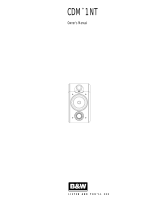 Bowers & Wilkins CDM 1NT Owner's manual
Bowers & Wilkins CDM 1NT Owner's manual
-
Bowers & Wilkins CDM 7NT User manual
-
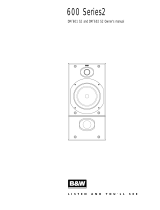 Bowers & Wilkins 600 Series2 Owner's manual
Bowers & Wilkins 600 Series2 Owner's manual
-
Bowers & Wilkins 603 S2 User manual
-
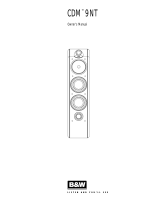 Bowers & Wilkins CDM 9NT User manual
Bowers & Wilkins CDM 9NT User manual
-
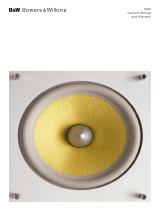 Bowers & Wilkins CM2 Owner's manual
Bowers & Wilkins CM2 Owner's manual
-
Bowers Wilkins DM 604 S3 User manual
-
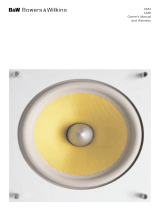 Bowers & Wilkins CM6 User manual
Bowers & Wilkins CM6 User manual
-
Bowers & Wilkins LCR 600 Owner's manual
-
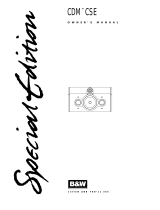 Bowers & Wilkins CDM CSE User manual
Bowers & Wilkins CDM CSE User manual






























